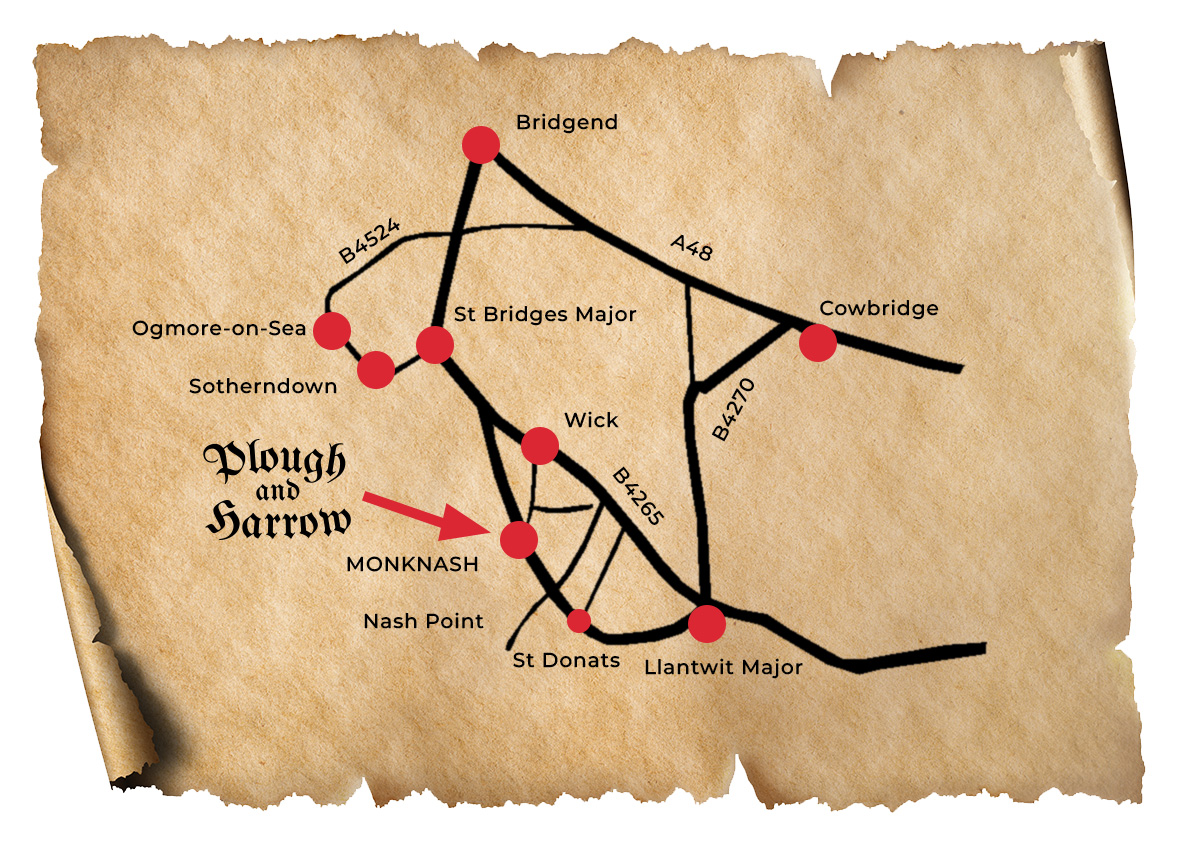Welcome to the Plough and Harrow in Monknash, a pub surrounded and steeped in history and now renowned for its wide range of real ales and freshly prepared home cooked food.
The pub dates back to 1383 and as the name Monknash suggests had a very strong ecclesiastical background. Local tradition claims that there was a monastery here and the Plough formed part of it, but in fact Monknash was a grange - an outlying farm established by a monastery to provide food and other goods.In that function it differed little from any secular farm, though there was usually a chapel on site (this being just to the east of the pub) and the estate was run by lay brothers, the "draught oxen of God" as one unflattering chronicle put it.
The monks' grange at Nash (hence the name) was the richest estate owned by the Cistercian abbey at Neath, it included accommodation buildings and a college (these recently have been rebuilt from ruins and can be found to the northwest of the pub), a forge (just down the lane to the west), a carpenters workshop (to the left of the pub), trout pools, dove cotes, animal buildings (ruins remain to the rear of the pub) and a huge tithe barn, over 200ft long, a building so large that the porch alone now accommodates a modern house!
To the left of the pub, the remaining ivy covered gable end can be seen from the garden but much of this barn was "robbed of stone" to build "newer" buildings over the centuries. All of this was surrounded by hundreds of acres of the best farming land in Wales. With the downfall of monastic houses in 1536 the land and buildings were sold off to the wealthy Stradling family o Donats Castle to the East, now home to Atlantic College.
The Plough is an example of a lobby entry house built at that time with its beamed ceilings, 'Tudor' doors and open fires. The bar is now one large room and all traces have been removed of the partitioned chamber which stood at the far end, along the dartboard wall. Perhaps this is a good thing, for there are stories told that this room was used to store the shipwrecked bodies washed up on the beach after having their ships captain confused by the infamous "Wreckers of Wick". They would tie lanterns around sheep's necks and then let them wander the cliff tops so the captains would think they were nearing the docks of Barry or Cardiff and not the jagged rocks of the coastline or the deadly Nash sandbank.
It is said that the bodies were stored until the coffins were made in the carpentry shop next door before burial at the church just up the lane. A legacy of the historical events is that the pub and surrounding areas are home to a number of ghosts who manifest themselves through activities such as tugging at the staff, moving furniture and holding conversations in an empty bar.
The Plough specialises in supporting micro-breweries, especially Welsh ones and there will always be an ale for everyone's taste.
Ales are either hand drawn from barrels in the cellar (where we also keep the Bass and numerous traditional ciders) or from gravity dispense in the barrels you can see behind the bar. The plough has won numerous awards for both its ales and food, both of which we believe should be fresh and expertly prepared. For this reason the food and ale menus change on a daily basis meaning there's always a reason to come back again!

The village of Monknash lies about 3 miles north - west of Llantwit Major, and can be reached from the M4 at junction 35. Follow the dual carriageway to Bridgend, and at the fifth roundabout take the sign posted turning to St Brides Major (B4265). About 1½ miles beyond St. Brides Major a sign posted right turn leads to Monknash anda Liantwit Major.



